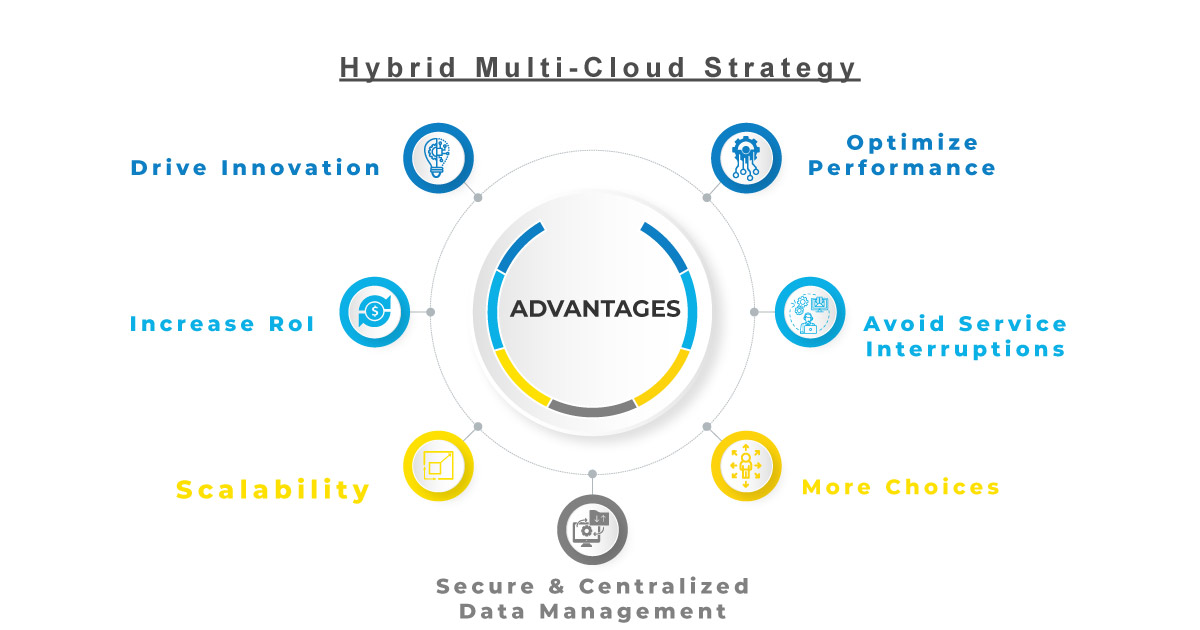Enterprises are increasingly opting for cloud computing to gain flexibility and scalability. While most organizations worldwide have switched to the cloud, optimizing this investment is not an easy task. To optimize their cloud investment, enterprises need to partner with cutting-edge cloud service providers. These efforts also require them to devise a strategy to adopt the right mix of cloud and on-premise IT infrastructure.
As these alignments and re-alignments take place, what seems to be gaining momentum is the switch to a hybrid and a multi-cloud strategy. This strategy is likely to become very popular in the market for several years to come.
It is important to remember that cloud computing can have a major impact on the business growth of an enterprise. Cloud computing helps create a scalable, reliable, and cost-effective business strategy.
Cloud computing is mainly classified into four categories. They are public cloud, private cloud, hybrid cloud, and multi-cloud. Enterprises prefer hybrid and multi-cloud due to their computing power, storage, and cost
According to Statista, the global hybrid cloud market was valued at $85 billion in 2021. It is likely to reach $262 billion in 2027.

Hybrid/Multi-Cloud Solutions
Hybrid IT solutions amalgamate the private cloud architecture, public cloud solutions, and legacy in-house infrastructure to enhance the overall cloud architecture. A hybrid cloud approach connects these components to create a single contained environment.
Multi-cloud solutions use at least two similar cloud services, such as multiple private cloud, multiple public cloud, or even in some cases multiple hybrid cloud. Multi-cloud solutions have mostly been sourced from leading cloud service providers, such as AWS, Azure, or Google Cloud.
Hybrid Multi-Cloud (HMC) strategy is becoming prominent with enterprises as it drives agility and brings about cost efficiency with innovation. HMC utilizes various cloud computing services from different cloud vendors, and private cloud deployment systematically distributes computing resources.
Hybrid Cloud & Multi-Cloud Environment
When a hybrid cloud has more than one public cloud added to its private cloud resources, it automatically becomes multi-cloud. A hybrid cloud approach helps align a single IT objective between a combination of public and private clouds. While a multi-cloud environment can use private cloud platforms, it doesn’t need to be labelled multi-cloud. A hybrid cloud includes the use of a private cloud or on-premise private cloud infrastructure at all times.
Businesses must evaluate the functioning and capabilities of a cloud provider thoroughly to develop an effective cloud strategy. Gemini Consulting & Services has helped many enterprises across the globe in building and implementing hybrid multi-cloud. Contact us to understand how a hybrid multi-cloud strategy can help your enterprise to accelerate growth.

- Drive Innovation
Cloud platforms and services provide a wide range of capabilities for businesses. It also can bring some cost savings and enhance productivity through the prudent distribution of the workload. This can help enterprises to focus more on their business objectives and growth. Hybrid multi-cloud strategies make it easier for businesses to develop new services and allow them to meet the demands of their consumers. For instance, say an organization wants to deliver a new app to production, the same can be tested on public cloud resources first.
- Increase RoI
Each cloud service provider offers a collection of functions, price models, and rules. While a dynamic business environment makes it tougher for businesses to identify one single cloud solution, a hybrid multi-cloud strategy allows businesses to select from various options that best suit their needs. This makes the businesses agile, and dependable and helps increase RoI when applications get distributed across multiple clouds.
- Secure & Centralized Data Management
A hybrid multi-cloud strategy brings about improved efficiency in data management via cloud orchestration and reduces the overhead of switching from one infrastructure to another. Including an on-site private environment provides firms with the benefit of granular control, transparency, and comprehensive visibility into their IT resources. This strategy will assist businesses in developing a distinct strategy while balancing security and cost benefits.
- Scalability
Any growth or an upward change in organizations may require the enterprise or business to make changes to the physical infrastructure. The combination of public and private cloud computing power allows businesses to scale up faster, helps them in quickly build their cloud architecture, and scales up or down their computing infrastructure. While this is not the case with a public cloud platform.
- More Choices
The hybrid multi-cloud strategy limits the vendor lock-in to a specific public cloud provider. This improves the speed to market and cost-effectiveness. Therefore, businesses should scrutinize and choose when selecting resources from multiple cloud providers.
- Avoid Service Interruptions
If a business exceeds the private cloud to maximum capacity, the overflowing traffic is routed to the public cloud, thereby, avoiding service interruptions. This is called cloud bursting. With this system, businesses can use hybrid multi-cloud to meet peak demand for applications or services without having to bear the high costs of overusing their data centers. In case of high demand, businesses can plan and configure apps that can typically run on private or on-premises clouds and can burst into the public cloud.
- Optimize Performance
Every organization sets out to accomplish the best it can with its resources. The hybrid multi-cloud strategy provides businesses with a lot of freedom. For instance, a business can use AWS spot and steady processing capacity at a reasonable price while continuing to use low-priority VMs on Azure or the private cloud.



